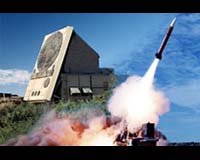| . |  |
. |
Canberra, Australia (UPI) Dec 24, 2009 The HMAS Melbourne has demonstrated the navy's updated naval air defense capability with the firing of a Standard Missile (SM-2) off Jervis Bay. Minister for Defense Personnel, Materiel and Science Greg Combet said in a written statement that the SM-2 would be further enhanced throughout 2010. "This missile firing was the first time an SM-2 has been fired from an Adelaide-class frigate," Combet said. "The missile was prepared, launched and supported in flight before engaging a target." Combet said Melbourne is now equipped with two modern missile systems to combat anti-ship missiles and aircraft. "HMAS Melbourne is an Adelaide-class guided-missile frigate (FFG) that has completed the multimillion-dollar FFG Upgrade Program and has recently undergone additional SM-2 related alterations to its combat system." The FFG Upgrade Program is to extend the life of the remaining four FFG ships in Australia's fleet. It also includes improvements to underwater warfare capabilities including torpedo systems. The Royal Australian Navy acquired four U.S. Navy-designed FFG 7-class guided-missile frigates in the late 1970s and early 1980s, according to the Australian Ministry of Defense. These ships -- HMAS Adelaide, Canberra, Sydney and Darwin -- were built by Todd Shipyards in Seattle. All together, the USN built 51 FFG7-class ships between 1976 and 1988. The USS Oliver Hazard Perry, lead ship of the Oliver Hazard Perry class of guided-missile frigates (FFG7), was named after the American naval hero who was victorious at the 1813 Battle of Lake Erie. She was scrapped in 2005. Australia built two more FFG7 frigates in 1983 at the Williamstown Naval Dockyard, now owned and operated by BAE. The HMAS Melbourne was delivered in 1992 and the HMAS Newcastle was delivered in 1993. The Adelaide and Canberra have since been retired from service and the others are undergoing the FFG upgrade. The SM-2 is a solid propellant-fueled, tail-controlled, surface-to-air missile fired by surface ships. It uses midcourse guidance for programming of the missile for radar search only, according to data available at Globalsecurity.com. The missile is redirected in midflight and then again during the terminal homing phase. SM-2, also the U.S. Navy's primary surface-to-air fleet defense weapon, is deployed in several different configurations, ranging from the SM-2 Block IIIA up through the SM-2 Block IV ER for the U.S. Navy's AEGIS-compatible ships. SM-2's primary role is to provide area defense against enemy aircraft and anti-ship missiles. The current generation of SM-2 Blocks IIIA and III has improved stability to increase performance against an advanced anti-ship missile threat. It is designed specifically to counter high-speed, high-altitude anti-ship cruise missiles. Thales Australia, the prime contractor and upgrade design authority for the FFG program, has subcontracted a number of Australian and overseas firms. These include Gibbs and Cox, Thales Underwater Systems, AAI, Lockheed Martin Naval Electronic and Surveillance Systems, and CEA. ADI is the combat system design and integration authority and is contracted to achieve an Australian industry involvement of at least 48 percent. Gibbs and Cox is the platform system design authority, and TUS, formerly Thompson Marconi Sonar, is the underwater warfare design agent. Share This Article With Planet Earth
Related Links Learn about missile defense at SpaceWar.com All about missiles at SpaceWar.com
 1.1 billion dollar Taiwan missile contract to Raytheon
1.1 billion dollar Taiwan missile contract to RaytheonWashington (AFP) Dec 23, 2009 US defense firm Raytheon said Wednesday it was awarded a contract worth 1.1 billion dollars for new Patriot missile systems to Taiwan. The contract had been in the works since 2008 when the Pentagon notified Congress it intended to allow Taiwan to buy newer, advanced interceptor missiles and other defense equipment. The military sales have drawn fierce objections from China, which consid ... read more |
|
| The content herein, unless otherwise known to be public domain, are Copyright 1995-2009 - SpaceDaily. AFP and UPI Wire Stories are copyright Agence France-Presse and United Press International. ESA Portal Reports are copyright European Space Agency. All NASA sourced material is public domain. Additional copyrights may apply in whole or part to other bona fide parties. Advertising does not imply endorsement,agreement or approval of any opinions, statements or information provided by SpaceDaily on any Web page published or hosted by SpaceDaily. Privacy Statement |